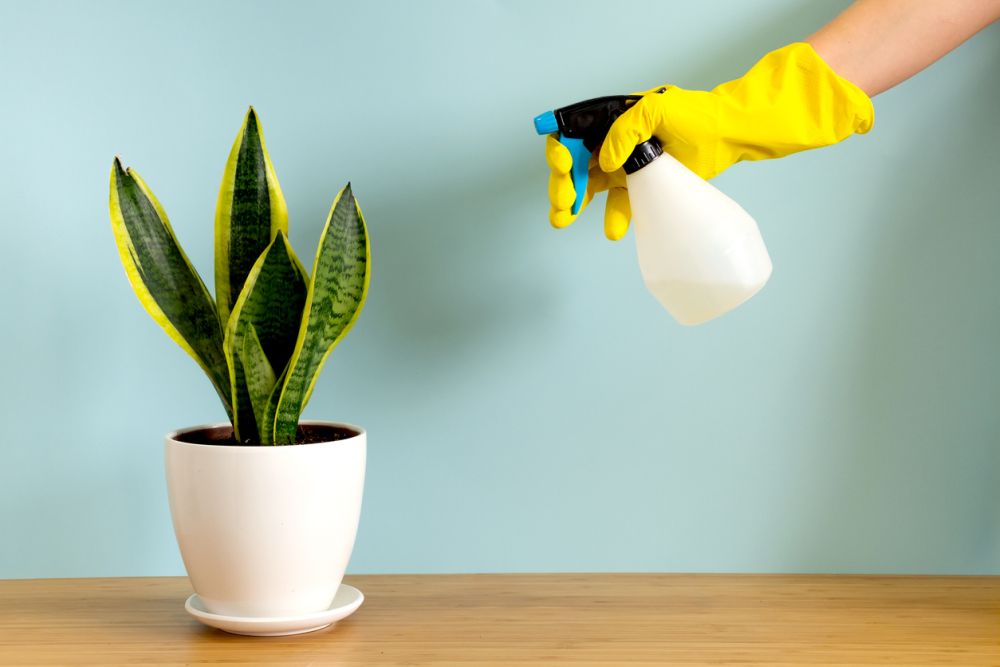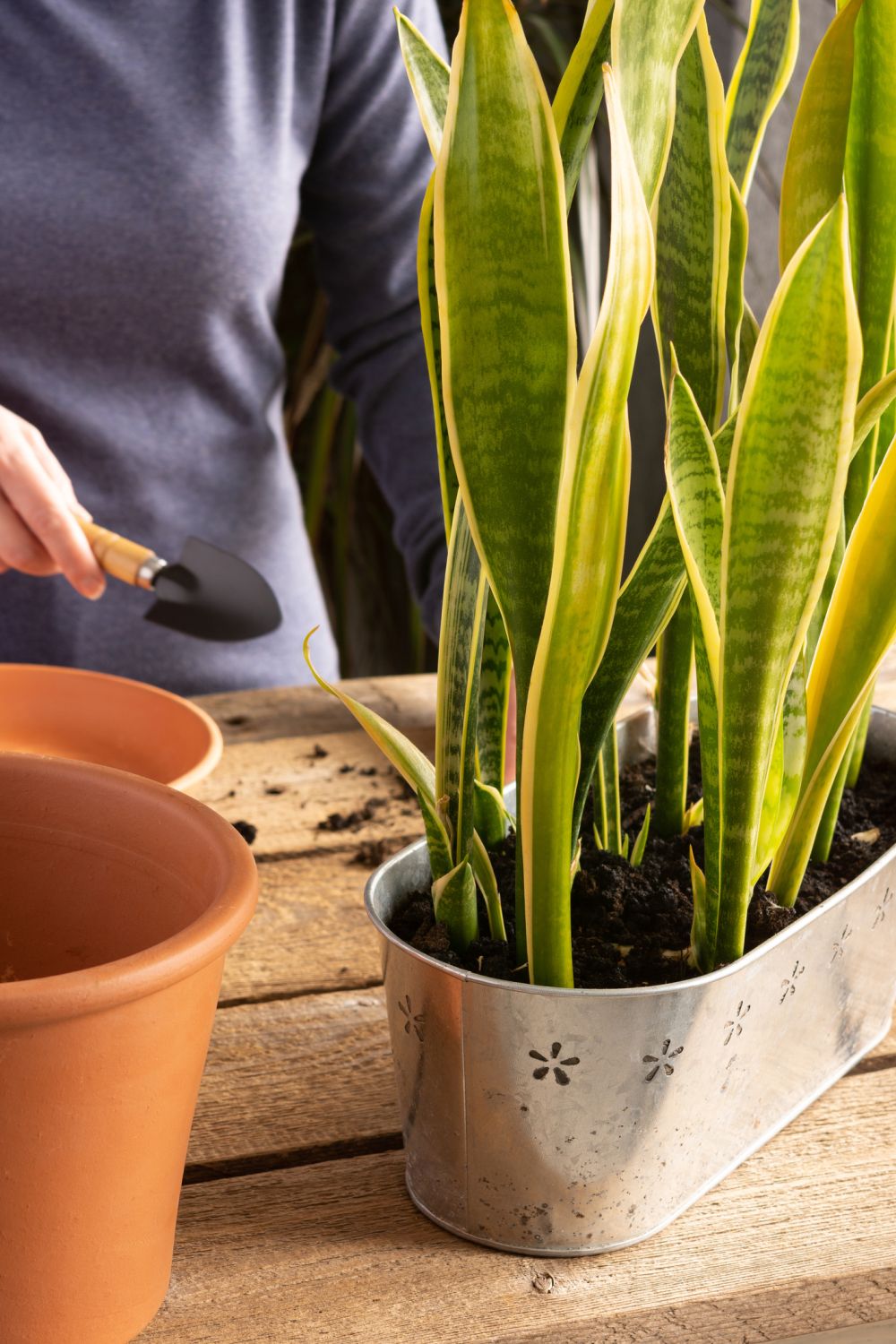How to Repot a Snake Plant in 6 Easy Steps
Repotting a snake plant (Dracaena trifasciata, Sansevieria) isn’t difficult, but it’s hard to tell the signs. Read on to discover when and how to repot your Sansevieria.

This article describes the supplies and step-by-step instructions for repotting a snake plant. You will also learn the signs that your Dracaena trifasciata needs repotting, tip for managing transplant shock, and additional information.
When should you repot a snake plant?
Snake plants like being root-bound to a certain degree, so it’s unnecessary to repot it as soon as its roots peek out of the drainage holes. In fact, it’s recommended to repot a snake plant only when it shows signs of distress. Otherwise, transplant your Sansevieria every 5-6 years. Here are the signs that your snake plant needs repotting:
- The soil doesn’t hold water: When watering your snake plant, check if it goes through the soil faster than usual. It tells you that the root system has taken up the soil’s space, so you must repot the Dracaena trifasciata to change its soil.
- Yellowing or wilting leaves: These are signs of distress that your snake plant needs more water. When regular watering doesn’t seem enough for the snake plant to strive, it could signify an overgrown root system that demands more. So you must repot your Sansevieria to a bigger container.
- Cracking or deformed pot: In severe cases, an overgrown root system may cause the pot to crack. Plastic pots become distorted.
- The snake plant is top-heavy: The snake plant’s aerial part and root system develop at the same rate. So a toppling snake plant indicates overdeveloped roots.
- The snake plant has pups: Snake plants habitually reproduce by developing pups (rhizomes) around their base. These pups have their own root system and contribute to pot overcrowding. In this case, repotting involves dividing and propagating your Dracaena trifasciata.
- Rotting leaves: Rot at the base of the leaves is usually caused by overwatering or poor drainage, so you must repot the snake plant to fix this issue.
- Impeded plant development: An overdeveloped root system requires more nutrients, slowing down or stopping the snake plant’s growth.
Supplies for repotting a snake plant
- New pot 1-2 sizes bigger than the current one with at least one drainage hole. Since snake plants are naturally top-heavy, pick wide pots over tall ones made from ceramics or terracotta. To prevent your snake plant from growing, reuse its current pot after cleaning it with soap and water; it will remove any trace of pests or disease from the old soil.
- A porous material to improve drainage. Examples include gravel, clay pebbles, or broken pottery pieces.
- Potting mix for snake plants or succulents like cacti. Make your own potting mix by combining 1 part coarse sand, 1 part pumice or perlite, 1 part peat moss or coco coir, and 2 parts regular potting soil.
- A dull knife or a trowel to dislodge the soil.
- Scissors, pruners, or gardening shears to trim the roots.
- A potting tarp or a newspaper to not make a mess on the working area.
How do you repot a snake plant?
Check out the step-by-step instructions for repotting a snake plant:
- Choose the right time for potting: Ideally, snake plants should be repotted in later winter or early spring. This way, their recovery time will coincide with their natural growth period.
- Prepare the new pot: Line the bottom with a layer of porous material and fill a third of the pot with soil.
- Remove the snake plant from its pot: Lay the old pot to its side and grab the snake plant by the base of its leaves. Use the other hand to gently tap the pot’s bottom to loosen up the soil. If it doesn’t budge, run a dull knife or a trowel along the edges. In the case of a plastic pot, carefully squeeze it to force the rootball to pop out.
- Clean the rootball: Use your fingers to remove excess soil clinging to the snake plant’s roots. Examine the roots: healthy ones are white and firm to the touch, while unhealthy ones are brown, black, or mushy. Trim away the unhealthy roots.
- Consider propagating the snake plant: Check if the pups have their own roots. In this case, separate the pups from the rest of the root system to discard or transplant them into new pots.
- Add the snake plant to the new pot: Place it into the new container, keep it upright, and add potting mix until the rootball sits about 2 in (5 cm) below the pot’s rim. Then pour the rest of the potting mix, gently compacting it until you have covered the rootball.
Tips for managing snake plant transplant shock
Snake plants experience transplant shock for 4-5 weeks after repotting, especially after trimming away many roots. During this time, the snake plant becomes extra sensitive to its surroundings and prone to pests and diseases. Follow these tips to speed up the snake plant’s recovery time:
- Watering: Thoroughly water the snake plant immediately after repotting. Subsequently, water it only when the top 1-2 in (2-5 cm) of soil are dry.
- Lighting: Keep the snake plants in bright, indirect sunlight.
- Fertilization: Avoid fertilizing your snake plant for at least a month after transplanting it to a new home.
- Temperature: Keep your snake plant at 60-75° F (16-24° C).
- Humidity: Snake plants before 30%-50% humidity. Keep them away from drafts.
FAQs
Discover more helpful information about repotting snake plants.
Do snake plants need deep pots?
No, snake plants don’t tolerate deep pots since their root system grows in a spread-out pattern. A deep pot filled with loamy soil would drain the water to the bottom, out of the reach of the snake plant’s roots.
Do snake plants like big or small pots?
Snake plants prefer small pots since they like being root-bound to a certain degree. At the same time, the container should be at least a third bigger than the rootball to have enough room to develop.
What kind of pots do snake plants like?
Terracotta pots are perfect for snake plants since they allow them to breathe. Terracotta pots allow water to evaporate through their pores to some extent, which pairs well with the snake plant’s natural affinity towards light loamy soils.
Closing thoughts
There are no secrets to repotting a snake plant. It’s not that different from repotting any other houseplant. The trick is interpreting the signs that your Dracaena trifasciata needs a new home, whether it’s root-bound or has depleted soil.

